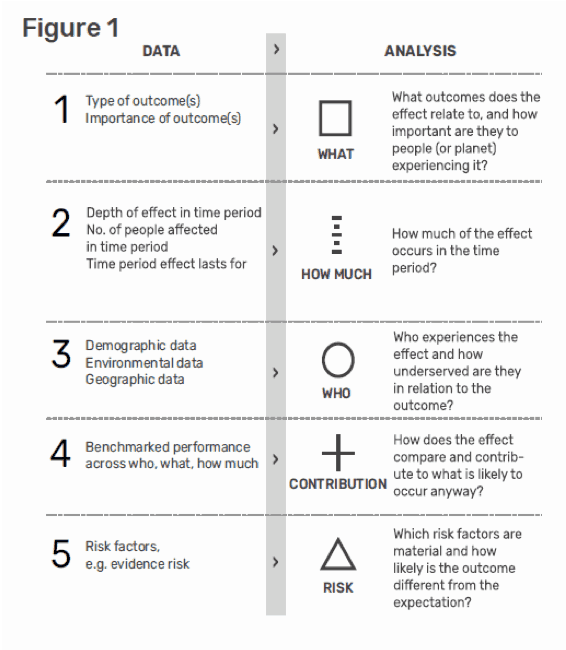Five Key Questions for Managing Impact – And How to Apply Them in Your Business
Every enterprise has effects on people and planet, positive and negative.
This statement is deceptively simple. Few would dispute that businesses have widespread effects on many aspects of our society and environment, but do we know what those effects are?
Businesses have every reason to develop a comprehensive understanding of their impact. For instance, if a company discovers that its customers are being harmed by a product or service, it might try to fix it because it’s worried about regulatory or reputational risk. If a manager notices that energy savings are unlocking commercial value, she might see the value in reducing usage and using renewables wherever possible. Or if an entrepreneur or board of directors believe their business can be a force for good, they might dedicate themselves to making sure its effects live up to that ideal for customers, employees, the environment and the local community (as modeled all over the world by B Corps).
But though they may have a gut feeling or intuition about their impacts, business leaders often find it difficult to articulate them clearly and comprehensively. They need to develop the ability to communicate the change they’re trying to achieve – and the performance they do achieve – in a way that others can understand, both within their company and outside of it.
The Five Dimensions of Managing Impact
Hundreds of investors, entrepreneurs, social scientists and evaluators from all over the world have come together through the Impact Management Project to make this easier. Members of the project now agree that we can understand and communicate a business’ effects on people and the planet by assessing five dimensions – what, who, how much, contribution and risk. Each effect can be understood and classified by asking the following questions:

- What outcome, positive or negative, does the effect drive (e.g. a decent level of income)? Is the outcome important to the people who experience it, or to the planet?
- Who experiences the effect (e.g. female employees in Tanzania) and how underserved were they relative to the outcome (e.g. people formerly on low or no wages)?
- How much of the effect occurs? Does the effect drive the outcome deeply (e.g. a big increase in wages for each person) and/or does it happen for many people? Does it last for a long time and/or happen quickly?
- How does the effect compare and contribute to what would likely happen anyway (e.g. relative to the market status quo, does the effect result in a bigger increase in wages and/or happen to a greater number of people and/or reach people who are more underserved)?
- What is the risk to people and planet that the impact does not occur as expected? (e.g. how good is our evidence that performance across these dimensions is what we think it is?)
It’s not practical to think that we have to measure and manage every impact that a business has on people and planet. But what would happen if we focused on managing deep, long-term and/or at-scale effects on important positive or negative outcomes – for people and the planet who are not already well-served?
This is what we call managing impact – and whether they’re running a new startup or a well-established multinational corporation, business leaders can use these questions to amplify their positive effects and minimize their negative ones.
A Startup Takes Action
Take the startup SOLARKIOSK, for example. For them, the answer to the “what” question started with the Sustainable Development Goals. They thought about which SDGs they could contribute to by expanding their network of “E-HUBBs” – an award-winning cleantech energy solution – in rural, off-grid regions of developing countries. They mapped their effects on different SDGs, and collated indicators from the Global Reporting Initiative (GRI) and IRIS across each of the other dimensions of their impact goals, so they could start tracking performance over time.
The first step was drafting a policy on potential negative impacts related to their work (for instance, the CO2 footprint from their travel) and creating clear company positions on each issue – as well as operational measures to contain and/or counter these issues over time. To assess their positive contributions to the SDGs, they are working to improve their stakeholder engagement strategy by gathering qualitative data from customers in the field – asking people what they’re actually experiencing, whenever possible. They are also partnering with academic institutions to help determine their contribution to the SDGs. To that end, they’re asking the tough but important question of how their effects compare with what likely would have happened anyway – and focusing on making sure their contribution to specific SDGs, like (8) Decent Work and (1) No Poverty, are deeper, longer-term and/or more scalable than other projects out there.
A Multinational Managing Impact
Multinational corporations are managing their impact, too. Take Mars, for example, a global company consisting of six different businesses – Petcare, Mars Wrigley Confectionery, Food, Drinks and Symbioscience – that recently launched its Sustainable in a Generation Plan. Guided by science, Mars is focusing on six important outcomes – climate, water, land, income, human rights, and health and wellbeing. Their plan will work to mitigate any negative effects that the company is currently generating in these areas – for example, reducing waste and marketing their products responsibly to promote appropriate consumption and counteract any potential negative effects on health outcomes. At the same time, they’re pursuing positive effects wherever possible – for example, by taking actions to ensure the safety and security of food ingredients and products for all populations, especially those at risk of malnutrition.
The Impact Management Project recently explored the shared fundamentals of Mars’ strategy on income within the Sustainable in a Generation Plan through an interview with Kate Wylie, the company’s global vice president of sustainability. She described how Mars is working to ensure that smallholder farmers (who) – and, in time, their extended supply chain – have a sufficient income to maintain a decent standard of living (what). They define sufficient income for each raw material that Mars buys from these farmers, based on what would be considered a deep driver of a decent standard of living – and they are doing this at scale, as quickly as possible (how much). As part of this effort, Mars also launched the Farmer Income Lab to work with a wide range of partners, improving the contributions of Mars and other stakeholders in its supply chain and mitigating their impact risk.
Investors Can Also Drive Impact
There’s another reason businesses are thinking about managing impact: because investors and funders are increasingly demanding this information. Consider Root Capital, an impact investor that provides loans and advisory services to agricultural businesses in Latin America, sub-Saharan Africa and Southeast Asia. To be considered for a loan via Root’s screening process, an enterprise has to avoid damaging human or environmental health and show signs of positive impact on farmers, workers and/or the environment.
Building consensus on how to understand, communicate and manage impact was an important milestone – but it’s just the beginning. The Impact Management Project is now focused on making this practical, working with enterprises, investors and intermediaries to co-create training materials and templates anyone can use. We envision a future where managing impact is as common as – and an inherent part of – business planning and financial analysis around the globe.
Amanda Feldman is a director on the Bridges Impact+ team, focused on the Impact Management Project.
Top image: Photo of a SOLARKIOSK E-HUBB in Rwanda. Image credit: SOLARKIOSK
- Categories
- Environment, Impact Assessment



